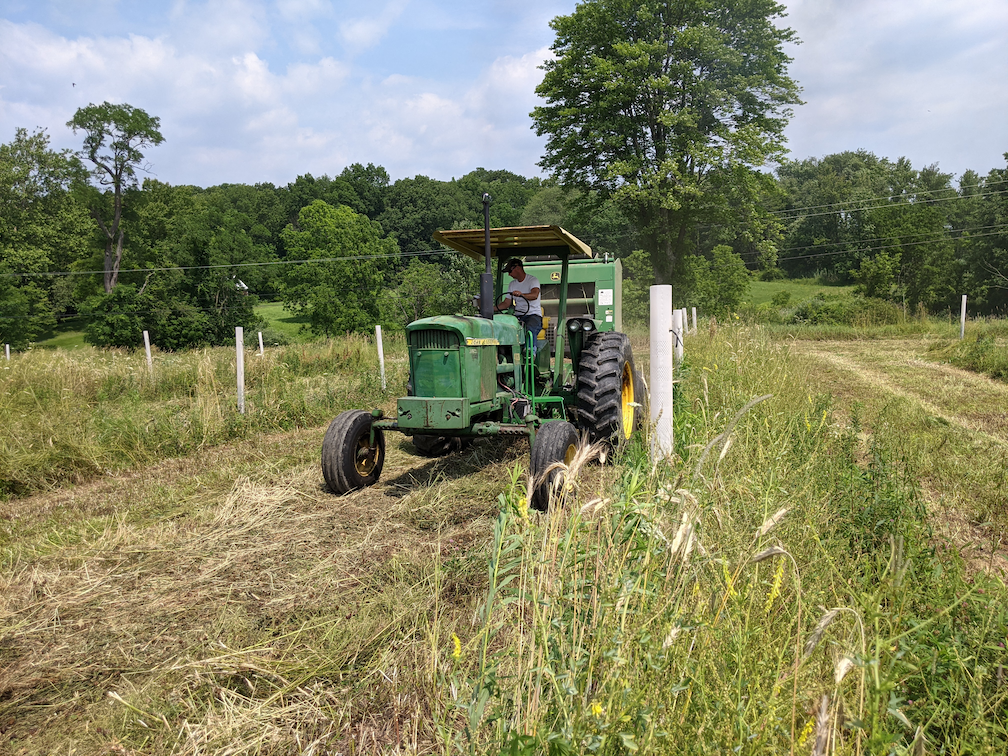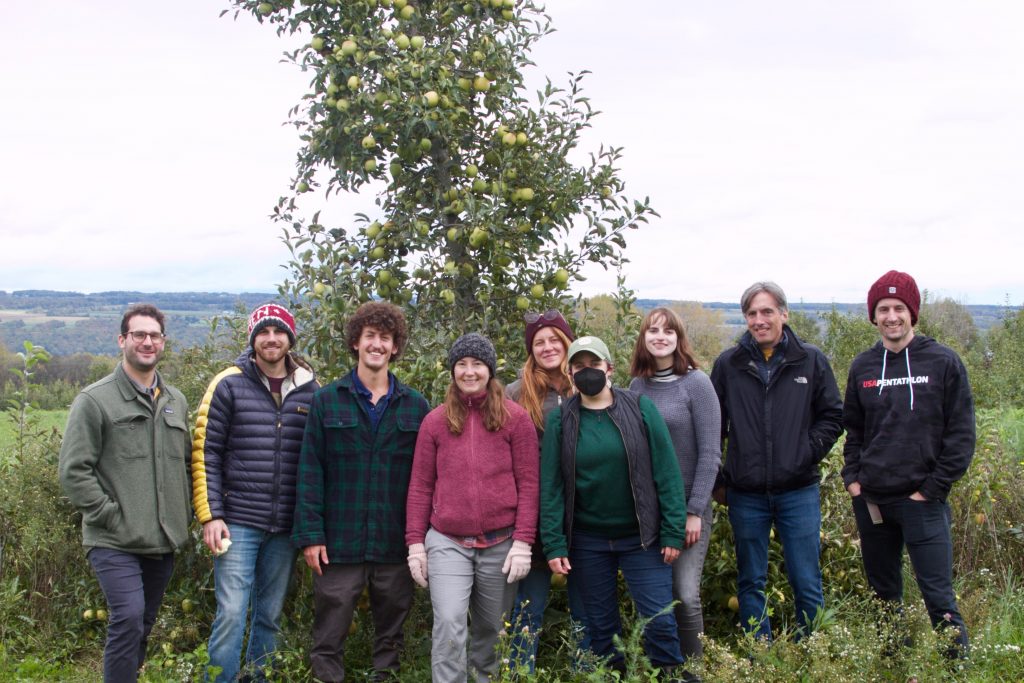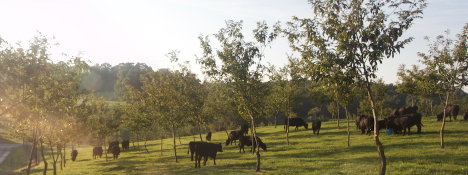Agroforestry is a management practice used around the world that has enormous potential to sequester carbon. According to a study published by Ecology Law Quarterly, “Even the most conservative estimates find that agroforestry sequesters two to five times more carbon per acre than the most effective—and better-known—climate-friendly practices for annual crops, such as no-till agriculture and cover crops. Agroforestry also offers substantial environmental and economic benefits: clean water, reduced fertilizer and pesticide use, greater resiliency, and higher profitability per acre.” Project Drawdown, a leading resource for global climate solutions, claims there are 1.6 billion acres of land under agroforestry management around the world. Yet, here in the U.S., the practice of integrating trees and shrubs into agricultural systems is less understood and far less common.
So, what has held agroforestry back in the U.S.? And how can this be addressed in order to add to our growing toolbox for regeneration and climate change mitigation? We had the opportunity to dig into this with Ethan Steinberg, co-founder and CEO of Propagate Ventures – a four-year-old tech start-up with a grand vision to expand agroforestry. With a unique, tech-based approach to addressing the barriers to agroforestry here in the U.S., Propagate has been quickly gaining momentum, closing a $1.6 million seed round in 2020, making significant strides in 2021, and preparing for a series A raise in 2022.
Why Agroforestry?
Years before incorporating in 2017, Propagate Ventures was just a group of friends – Steinberg, Jeremy Kaufman, and Harrison Greene – wrestling with some big questions about the food system. Despite diverse professional backgrounds, they found themselves wondering how to build ecologically healthy landscapes that could supply equally as healthy food. The three had personal reasons for this exploration, Steinberg explains, “Jeremy and I had approached agriculture through the lens of our health (for example, I am diabetic) and Harry approached it from the lens of athletic performance (he was an Olympic hopeful). So good quality food meant everything to us, and we were desperate for solutions that fostered ecological health while growing nutrient dense foods.”
As the three dug into the connections between agriculture, ecological health, and nutrient dense foods, they realized that truly regenerative systems at a commercial scale were far from the norm. At the time it was rotational grazing and grass-fed beef systems that were getting attention and capital allocation from the regenerative space, but they saw that agroforestry held much underdeveloped potential. The trio didn’t understand why tree crops – a well understood asset, as well as the most resilient and stable crops over a longer period of time – were being neglected. They saw and still see agroforestry as a huge white space opportunity for climate, for farmers, and investors.
Agroforestry Dollars and Sense
Steinberg explains it like this: there are 158 million acres of farmland (or 20% of all U.S. farmland) suitable for tree crops[1], according to the Savanna Institute, and agroforestry can sequester between 2-8 tons of carbon per acre per year[2], depending on several factors. Converting this entire acreage to agroforestry practices could create value through emissions reduction, carbon credits, and increased on-farm value, all totaling up to $58B. Here’s how:
Farmer Value:
With agroforestry it is possible to increase annual per-acre earnings by $35 per acre[3]. With 158 million acres in agroforestry, that is another $5B in cumulative earnings for farmers. Steinberg explains that we also need to account for the value driven from the production of fruit, nut and timber. This makes the number grow by multiples, making the potential MOIC (Multiple of Invested Capital) on an agroforestry project landing somewhere between 2-4x and/or the IRR (Internal Rate of return) between 8-12%.
Emissions reduction:
The US agriculture industry emits about 698 million metric tons[4] per year with about $51 of social cost per ton of carbon[5]. If 158 million acres were converted at 8 tons of carbon sequestrations per acre per year, it would be possible to wipe away the entire annual emissions of the US agriculture industry (with the potential to create more than 500 million metric tons of net benefit). So, U.S. agroforestry’s potential worth can be valued, at least, at the $35B in social costs that could be mitigated by this large-scale adoption.
Carbon Credits:
At $15 per ton of carbon it could also be possible to generate $18.96B in value based on liberal sequestration estimates, or at least $4.74B based on more conservative estimates.
Steinberg acknowledges this is an ambitious estimation but, “At the end of the day, I think the opportunity in the US is massive and in the billions, and if done correctly, we’re talking about an industry that is potentially larger than the entire organic food industry. But the work to make these numbers a reality is going to take an even bigger effort. We need the world’s smartest minds on this as the net impact is extraordinary.”
This need catalyzed Steinberg, Kaufman, and Greene set out to make agroforestry a cornerstone of agriculture by focusing on removing the barriers that existed for expansion.
“At the end of the day, I think the opportunity in the US is massive and in the billions, and if done correctly, we’re talking about an industry that is potentially larger than the entire organic food industry. But the work to make these numbers a reality is going to take an even bigger effort. We need the world’s smartest minds on this as the net impact is extraordinary.”
Eliminating Barriers
Propagate Ventures identified three major risk areas that serve as barriers to the expansion of agroforestry in the U.S. – operational risk, business risk, and financial risk – and they are definitively focused on addressing these in their work. “Our role is an enabling one,” says Steinberg. “We’re focused on enabling more services, businesses, and stakeholders to get involved in this growing industry… (and) to help offload these risks from the parties that feel them the most; farmers, corporates and investors.”
Operational risk refers to the on-the-ground challenges of implementing and working with agroforestry systems. For most operations, integrating agroforestry is a diversification strategy – meaning tree crops are utilized to diversify on-farm income streams or to help maximize margins for the core operation. With a limited number of agroforesters operating in the U.S. today, education and training about how to integrate agroforestry systems is a key piece of the adoption puzzle. To address this operational risk, Propagate Ventures has built Overyield.com – a SaaS tool that helps farmers, landowners and service providers design and analyze agroforestry systems so that they can generate more profit per acre, reducing the barrier for knowledge transfer in agroforestry.

“Think of this as a comprehensive platform on agroforestry management,” says Steinberg. “We’ve deployed a number of best practices that have been vetted across our agroforestry hub(s), so that the on-farm management of these systems is clear. Expertise comes from university-research studies, historical data from practitioners, as well as real time data coming from our farm partners.”
Business risk for agroforestry stems from the nascent nature of the industry, meaning the downstream infrastructure, such as equipment, labor, processing, storage, is underdeveloped. While interest in investing in mid-stream infrastructure is growing, such investments aren’t likely to be executed until there is sufficient agroforestry crop production to warrant said infrastructure investment. Steinberg explains, “This is where we hit the classic ‘chicken and egg’ situation. Buyers of agroforestry goods, like a consumer brand, are unable to take on the risk of implementing more acreage due to the time it takes for trees to become productive (2-4 years for shrub fruits, 5-8 years for tree fruits, 8-10 years for tree nuts, and 15+ years for timber). Meanwhile, growers are not willing to take on costs and management risks of planting more acreage without knowing who will buy.” Propagate addresses business risk by creating more security around the business transactions that need to take place in order for our industry to grow. By working with farm partners to aggregate supply on a regional basis, the farmers’ seat at the table with buyers holds more weight and provides a layer of risk mitigation.
Financial risk in agroforestry, and regenerative agriculture in general, arises from a misalignment between the financial system’s expectations and the realities of photosynthesis – meaning the time required for trees to reach maturation. Trees are appreciating assets that host a higher upfront cost to implement, making them more expensive in the short term, but much more valuable in the long-term. “We believe the equation for success in regen ag includes money and time,” says Steinberg. “If we’re able to drive capital to the right place and give those systems the appropriate amount of time to prosper, then we’ll be on a path to a thriving regenerative agriculture/agroforestry industry.”
Knowing that productive assets are the lynchpin in creating value in agriculture, Propagate is working on making it easier to plant at no additional cost and working to automate more of the process for agroforestry development than anyone else. By using all of the key information and project development resources that become accessible through Overyield, Propagate can run due diligence on the most financeable opportunities on farm, making it easy for farmers to do things like purchase genetic stock and cover the OPEX (Operating Expense) requirements that are necessary to ensure that agroforestry systems generate an attractive return.
“The trick,” says Steinberg, “is to provide the capital required at the exact moment it is needed on the farm, allowing investors to invest with little risk around technology, operations & maintenance, and off-take & supply. Ensuring that operational standards can be met with the needed training and capital. To effectively commercialize agroforestry, we are oriented on solving the exact needs on-the-ground, matching the lifecycle events that occur on a farm’s agroforestry journey so that the industry can evolve from R&D to piloting to scale-up, and eventually to commercialization.”
Propagate’s ability to forecast project viability allows them to offer a managed financing option for the establishment of and transition to agroforestry, alongside regionalized outsourced farm management solutions (designed to mitigate the technical and business risks). They can then build partnerships with farmers, allowing investors and farmers to participate in the upside of sold produce or timber.
Steinberg likens where agroforestry is today to the solar industry 20 years ago – with few banks involved in solar, and a scarcity of software providers, hardware manufacturers, and operational contractors – only, he is anxious to point out, “we don’t have the luxury of the next 20 years to figure out how to get agroforestry right. At Propagate we are reducing the operational, business and financial risks that agroforestry (and regen ag) have, so that we can scale up in a much faster timeline than it took the solar industry to. We’re building the tools necessary and enabling access to the resources needed for the world’s growing agroforestry community to become the most impactful contingent of climate-smart agriculture.”
“We don’t have the luxury of the next 20 years to figure out how to get agroforestry right. At Propagate we are reducing the operational, business and financial risks that agroforestry (and regen ag) have, so that we can scale up in a much faster timeline.”
Making a Dent
In the four years that Propagate Ventures has been developing and executing this strategy, they have seen awareness and adoption of agroforestry increase. The operation currently advises across more than 18k acres, spanning 13 states from TX to WI to VT – representing 42 farms and more than 500k trees in the pipeline to be planted. The company also works across diverse customer segments, including farmers & farmland owners, technical service providers (i.e. landscape designers, agronomists), food brands, environmental non-profits, and agribusinesses that service the areas of agriculture, animal nutrition and protein, food, and financial & industrial services.

When asked what he is most proud of to this point, Steinberg reflects on how far he and his friends have come from the young entrepreneurs with a “mega (and crazy) idea” to expand agroforestry. He says it is heartwarming to “know that there is an entire universe of people who believe in the ambitious vision we have for the future of agriculture.” He also beams with pride about the team, which has tripled since 2017, and who are the “smartest and hardest working team in the biz.” Lastly, he’s proud to witness and be a part of the growth of agroforestry in the past five years. “Propagate is only one of many organizations working on this, and we’re entering a phase where our industry is hitting its teenage years…we’re scaling up. That is pretty magnificent to see.”
What’s Next?
By the end of this year, Steinberg believes Propagate will reach 20k acres under advisement, 60 projects, and close to 600k trees – a number he thinks will multiply by 10x in the next few years. In 2022, the company will raise their next investment round to fund further growth. This will be their Series A raise and Steinberg is excited to work with investors who can provide strategic value and help scale Propagate to the next level.
He adds, “We believe that by helping farmers focus on permanent crops and timber in regenerative agriculture, a practice known as agroforestry, farmers become more resilient and investors can earn great returns. Collectively, these groups will build the next generation of regenerative farms.”
—
Interested in chatting with Propagate Ventures about their upcoming investment round? Click here to reach Ethan Steinberg.
Interested in working with Propagate Ventures or using Overyield.com? Fill out this form here.
—
[1] Savannah Institute. Overcoming Bottlenecks in the Eastern US Chestnut Industry. June 2021.
https://www.savannainstitute.org/wp-content/uploads/2021/06/2021-SI-Chestnut-report.pdf.
[2] Toensmeier, E. The Carbon Farming Solution: a Global Toolkit for Perennial Crops and Regenerative Agriculture Practices for Climate
Change Mitigation and Food Security. Chelsea Green Publishing, 2016. http://carbonfarmingsolution.com/carbon-sequestration-rates-and-stocks.
[3] Dupraz C., Burgess P., Gavaland A., Graves A., Herzog F., Incoll L.D., Jackson N., Keesman K.,
Lawson G., Lecomte I., Laigre F.., Mantzanas K., Mayus M., Moreno G., Palma J.,
Papnastasis V., Paris P., Pilbeam D.J., Reisner Y., Van Noordwijk M., Vincent G., and
Werf Van der W. 2005. Synthesis of the Silvoarable Agroforestry for Europe (SAFE)
Project; INRA-UMR System.
[4] USDA ERS – Charts of Note. https://www.ers.usda.gov › data-products › charts-of-note
[5] Interagency Working Group on Social Cost of Greenhouse Gases (IWGSC), United States
Government. 2021. Technical Support Document: Social Cost of Carbon, Methane, and
Nitrous Oxide Interim Estimates under Executive Order 13990.
Sarah Day Levesque is Managing Director at RFSI & Editor of Raising Regenerative News. She can be reached at sdaylevesque@questorcorp.com.
